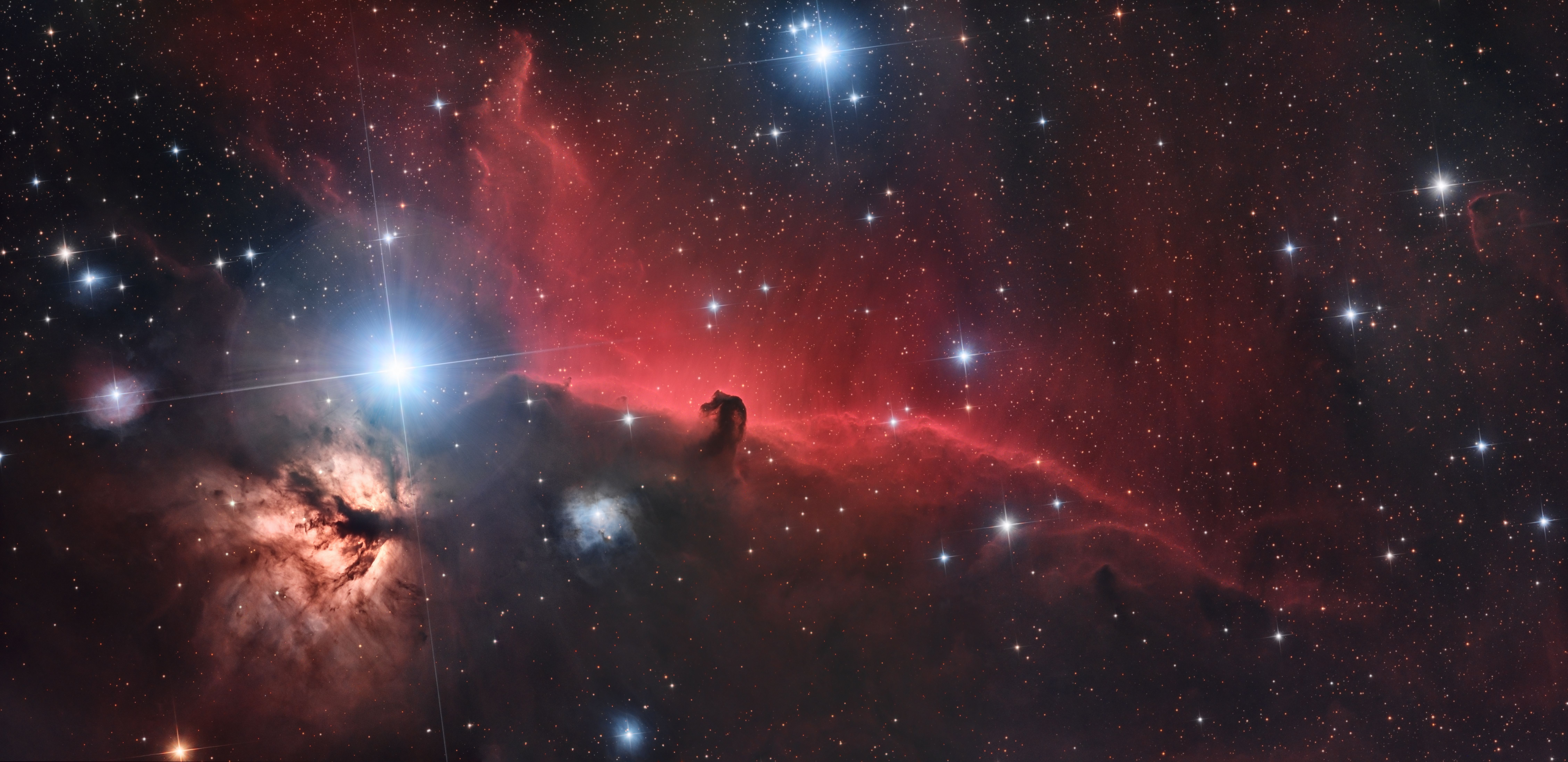Horsehead and Flame Nebula

A couple months ago I had the plan to image the famous horsehead, however a single panel failed to include a lot of the interesting surrounding nebulosity and so I upped it to a 3 panel.
On top of that I decided to make it an HaLRGB image, I estimated roughly 11 hours per panel, 5 to Ha, 3 to L and 3 to RGB. In actuality it equated to 32.5 hours total!
This has been my most ambitious project yet, I spent over a month just acquiring the sufficient data, several days spent processing (9k x 4k images are slow on my computer)
Other notes:
Definitely a few hiccups can be noticed at 1:1 scale, primarily red channel on the central panel was out of focus and so the stars were quite bad, still residual issues.
The noise profile differs between the panels and so an edge can be spotted.
HFR/FWHM on the right panel is much greater due to lower guiding quality. (possibly nights with bad seeing)
Date Created: 2019-11-21
Date Posted: 2019-12-28
Acquisition Details:
Scope: GSO 8" F/4, flocked, 2" moonlite, DIY AutoFocuser, DIY Secondary Dew Heater Coma Corrector: SkyWatcher Aplanatic/Quattro Camera: ZWO ASI 1600MMC PRO (Image scale ~1"/pixel) Mount: EQ6-R Guide Scope: ZWO 60mm Guide Cam: QHY5LIIC All ZWO LRGBSHO filters Acquired from 21/11/2019 till 23/12/2019. approx 1 whole month for acquisition. Integration times: Panel 1: L: 87x120s (2.9 hr) Ha: 78x300s (6.5 hr) R: 36x120s (1.2 hr) G: 25x120s (0.83 hr) B: 22x120s (0.73 hr) panel total: 12.16 (hr) Panel 2: L: 88x120s (2.933 hr) Ha: 57x300s (4.75 hr) R: 41x120s (1.36 hr) G: 51x120s (1.7 hr) B: 44x120s (1.47 hr) panel total: 12.2 hr Panel 3: L: 74x120s (2.47 hr) Ha: 49x300s (4.08 hr) R: 18x120s (0.6 hr) G: 15x120s (0.5 hr) B: 14x120s (0.46 hr) panel total: 8.11 hr Grand Total: 32.5 hours All at 21 offset, -15 degrees celsius. LRGB at gain 76, Ha at unity (139). Acquired with the NINA imaging suite. Guided with PHD2. Mount interface: EQMODProcessing Details:
Created 12 stacks, HaLRGB per panel. (3 panels) The RGB for each panel was ABE'd, then linear fitted then RGB combined, resulting in 3 RGB images representing each panel. Each L panel had DBE applied, TGV and MMT for NR. Each Ha panel had the same as L but additionally Deconvolution. 3 Mosaics were then created from all these panels as such: Platesolved central panel, created a Catalog Star image the size of the mosaic (10kx4k) Star aligned each panel to this catalog star image. DNALinearfitted the 3 panels. GMM to combine. As a result an Ha, L and RGB mosaic were generated. Then L and R (in the RGB) were enhanced with the Ha via the pixel math detailed in the LVA tutorial. The RGB was then stretched slightly with arcinsh and then HT. The L was stretched with just HT. Then had to perform a fix on the stars in the central panel red channel of the RGB mosaic. This stack used out of focus red data, and I for some reason let it progress this far down the line without noticing (I guess this is what you get for processing at 3am). This fixed involved making a starmask using starnet and then clonestamping out in focus stars. Applying mask to the red channel and using deconvolution motion blur. Star reduction on both the RGB and L. LRGB Combination with chrominance NR. Several rounds of curves and LHE with masks targetting different brightness regions of the image. Masked out the flame nebula to shift the red hues away that come from the Ha. This achieves the normal RGB look which is more appealing for the flame. HDRMT on small reflection nebula (really minor) Brought image into PS for Selective colour, toyed with the sliders to push the pinky reds into a deeper red colour. Back into PI, using starnet, desaturated the reds in the stars (rather intense red stars from arcinsh). Bit of clone stamping out some artefacts from GMM and blue spike from alnitak that extended the whole image.Date Created: 2019-11-21
Date Posted: 2019-12-28
